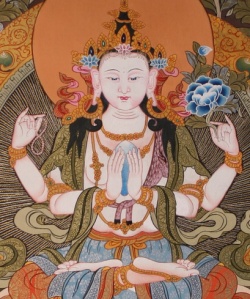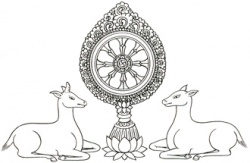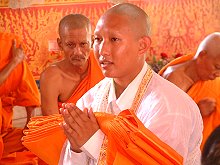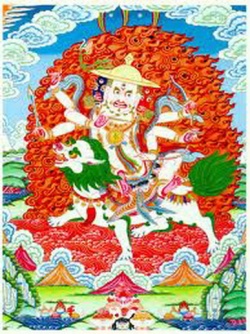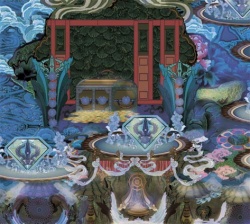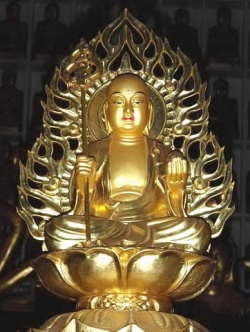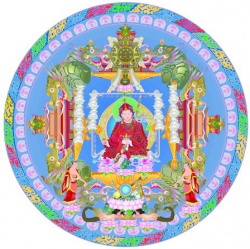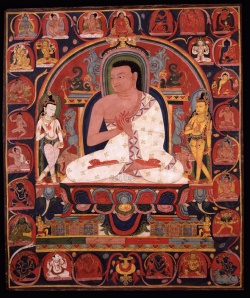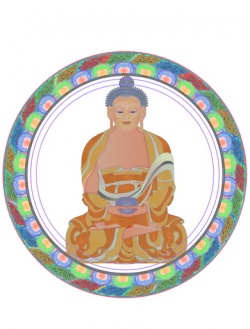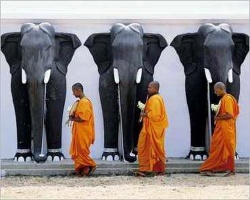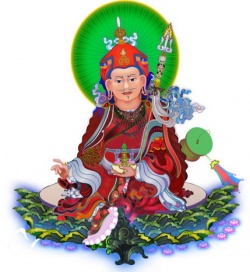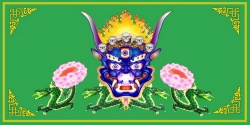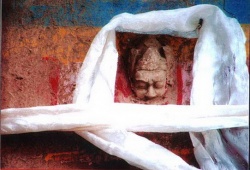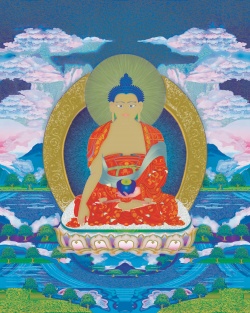Difference between revisions of "Abhidharmakosha Vasubandhu Chapter 5"
(Created page with " <poem> Abhidharmakosha chapter 5 Chapter 5: pañcamaṁ kośasthānam CHAPTER FIVE – THE LATENT DEFILEMENTS pañcamaṁ kośasthānam om namo buddhāya mūlaṁ...") |
|||
| Line 1: | Line 1: | ||
| − | + | {{DisplayImages|2843|3299|3427|2865|970|1491|2365|1281|791|3152|730|2450|1816|1717|856|1784|650|296|2581|681|3047|583|2970|906|171}} | |
<poem> | <poem> | ||
[[Abhidharmakosha]] chapter 5 | [[Abhidharmakosha]] chapter 5 | ||
Revision as of 10:35, 6 April 2014
Abhidharmakosha chapter 5
Chapter 5: pañcamaṁ kośasthānam
CHAPTER FIVE – THE LATENT DEFILEMENTS
pañcamaṁ kośasthānam om namo buddhāya
mūlaṁ bhavasyānuśayāḥ ṣaḍrāgaḥ pratighastathā|
māno'vidyā ca dṛṣṭiśca vicikitsā ca te punaḥ||1||
The roots of existence, that is, of rebirth or of action, are the anuśayas. Six: attachment, and then anger, pride, ignorance, false views, and doubt. These six make seven through the division of attachment.
ṣaḍrāgabhedātsaptoktāḥ bhavarāgo dvidhātujaḥ|
antarmukhatvāttanmokṣasaṁjñāvyāvṛttaye kṛtaḥ||2||
Attachment to existence arises from the two Dhātus. It is so called because it is turned within, and in order to avoid the idea that these two Dhātus are deliverance.
dṛṣṭayaḥ pañca satkāyamithyāntagrahadṛṣṭayaḥ|
dṛṣṭiśīlavrataparāmarśāviti punardaśaḥ||3||
There are five (erroneous) views: a belief in a self (satkāyadṛṣṭi), false views (mithyādṛṣṭi), a belief in the extremes (antagrāhadṛṣṭi), the esteeming of views (dṛṣṭiparāmarśa), and the esteeming of morality and ascetic practices (śīlavrataparāmarśa): thus there are ten anuśayas.
daśaite saptāsaptāṣṭau tridvidṛṣṭivivarjitāḥ|
yathākramaṁ prahīyante kāme duḥkhādidarśanaiḥ||4||
With the exception of three or two views, ten, seven, seven, eight anuśayas are abandoned in Kāmadhātu by the Seeing of Suffering and the three other Truths respectively.
catvāro bhāvanāheyāḥ ta evāpratighāḥ punaḥ|
rūpadhātau tathārūpye ityaṣṭānavatirmatāḥ||5||
Four are abandoned through Meditation. The same, with the exception of the angers, for Rūpadhātu. The same in Ārūpyadhātu. In this way, there are ninety-eight.
bhavāgrajāḥ kṣāntivadhya dṛggheyā eva śeṣajāḥ|
dṛgbhāvanābhyām akṣāntivadhyā bhāvanayaiva tu||6||
When they arise in Bhavāgra (the highest state of Ārūpyadhātu), the anuśayas which are struck by the kṣāntis are abandoned through Seeing and through Meditation. The anuśayas which are not struck by the kṣāntis are only abandoned through meditation.
ātmātmīyadhruvocchedanāstihīnā gradṝṣṭayaḥ|
ahetvamārge taddṛṣṭiretāstāḥ pañca dṛṣṭayaḥ||7||
The view of self and things pertaining to self, the view of eternity and annihilation, the view of negation, the view that holds as high that which is low, and that which holds for cause and Path that which is not cause and Path: these are the five views.
īśvarādiṣu nityātmaviparyāsāt pravartate|
kāraṇābhiniveśo'to dūḥkhadṛggheya eva saḥ||8||
If one clings to the idea that the Lord, etc., is the cause of the world, this is by reason of false conceptions of permanence and personality. Thus this clinging is to be abandoned through Seeing (the Truth) of Suffering.
dṛṣṭitrayādviparyāsacatuṣkaṁ viparītataḥ|
nitīraṇāt samāropāt saṁjñācitte tu tadvaśāt||9||
One distinguishes four errors within the three views. Reflective judgment and affirmation because they allow complete error. Thought and idea are termed “error” by reason of view.
sapta mānāḥ navavidhāstribhyaḥ dṛgbhāvanākṣayāḥ|
vadhādiparyavasthānaṁ heyaṁ bhāvanayā tathā||10||
There are seven types of pride (māna): Three make nine types. They perish through Seeing and Meditation. The paryavasthāna of killing, etc., is abandoned through Meditation; [the thirst for non-existence, etc.]
vibhavecchā na cāryasya saṁbhavanti vidhādayaḥ|
nāsmitā dṛṣṭipuṣṭatvāt kaukṛtyaṁ nāpi cāśubham||11||
The thirst for non-existence, etc. Among the Āryans the various types of pride, etc., and egotism, [-because they are nourished by views-] and bad regret, are impossible. Because they are nourished by views.
sarvatragā duḥkhahetudṛggheyā dṛṣṭayastathā|
vimatiḥ saha tābhiśca yā'vidyā'veṇikī ca yā||12||
Universal anuśayas are 1. the erroneous views and doubts which are abandoned through the Seeing of Suffering and Arising, 2. the ignorance which is associated with them, and 3. independent ignorance.
navordhvālambanā eṣāṁ dṛṣṭidvayavivarjitāḥ|
prāptivarjyāḥ sahabhuvo ye'pyebhiste'pi sarvagāḥ||13||
Among them, nine, with the exception of the two views, bear on the superior. With the exception of the prāptis, dharmas coexistent with the universal anuśayas are also universals.
mithyādṛgvimatī tābhyāṁ yuktā'vidyā'tha kevalā|
nirodhamārgadṛggheyāḥ ṣaḍanāsravagocarāḥ||14||
Wrong views, doubt, and the ignorance which is bound (yukta) to them, and independent ignorance, abandoned through the Seeing of Extinction and the Path, make six anuśayas whose object is pure.
svabhūmyuparamo mārgaḥ ṣaḍbhūminavabhūmikaḥ|
tadgocarāṇāṁ viṣayo mārgo hyanyo'nyahetukaḥ||15||
The extinction of their own bhūmi is the object of the anuśayas which have extinction for their sphere; the Path with its six or nine bhūmis, is the object of the anuśayas which have the Path for their sphere, for the Paths depend on one another.
na rāgastasya varjyatvāt na dveṣo'napakārataḥ|
na māno na parāmarśau śāntaśuddhyagrabhāvataḥ||16||
Lust does not bear on pure dharmas, because lust should be rejected. Anger does not, because pure dharmas do not do evil. 16c. Egotism and the two esteemings do not, because pure dharmas are calm, pure, and excellent.
sarvatragā anuśayāḥ sakalāmanuśerate|
svabhūmimālambanataḥ svanikāyamasarvagāḥ||17||
Universal anuśayas, relative to the object, become anuśayana in all their spheres; the nonuniversals, in their one category.
nānāsravordhvaviṣayāḥ asvīkārādvipakṣataḥ|
yena yaḥ saṁprayuktastu sa tasmin saṁprayogataḥ||18||
Not the anuśayas that bear on the pure dharmas or a higher sphere, because their object is not “made one’s own” and opposes the anuśayas. Any anuśaya which is associated with a certain dharma becomes anuśaya through association with this dharma.
ūrdhvamavyākṛtāḥ sarve kāme satkāyadarśanam|
antagrāhaḥ sahābhyāṁ ca mohaḥ śeṣāstvihāśubhāḥ||19||
All the “higher” dhyānas are morally neutral. The belief in a self, a belief in extremes, and ignorance are neutral in Kāmadhātu. The other anuśayas, here, are bad.
kāme'kuśalamūlāni rāgapratighamūḍhayaḥ|
trīṇyakuśalamūlāni tṛṣṇā'vidyā matiśca sā||20||
Lust, anger and mūḍi, in Kāmadhātu, are roots of evil. Three roots, desire, ignorance, and mati (that is, prajñā) are neutral. The others are not roots, because their modality is of duality and elevation.
dvidhordhvavṛtternāto'nyau catvāryeveti bāhyakāḥ|
tṛṣṇādṛṅmānamohāste dhyāyitritvādavidyayā||21||
Four, [say the Aparāntakas]: desire, views, egotism, and delusion which are neutral; in fact there are three contemplations based on ignorance.
ekāṁśato vyākaraṇaṁ vibhajya paripṛcchya ca|
sthāpyaṁ ca maraṇotpatti viśiṣṭātmā'nyatādivat||22||
Categorical response, as for death; a distinguishing response, as for rebirth; a response by question, as for superiority; and a response by rejecting the question, as for non-identity.
rāgapratighamānaiḥ syadatītapratyupasthitaiḥ|
yatrotpannā'prahīṇāste tasmin vastuni saṁyutaḥ||23||
One is bound by lust, anger, and egotism, past and present, to the object from whence they have been produced without their having been abandoned.
sarvatrānāgatairebhirmānasaiḥ svādhvike paraiḥ|
ajaiḥ sarvatra śeṣaistu sarvaiḥ sarvatra saṁyutaḥ||24||
One is bound to all objects by the same future kleśas, since they are mental states. One is bound to the object of their time period by the same future kleśas, since they are not mental states. Not destined to arise, one is bound everywhere by the same. One is bound everywhere by the others, whatever they are.
sarvakālāstitā uktatvāt dvayāt sadviṣayāt phalāt|
tadastivādāt sarvāstivādā iṣṭāḥ caturvidhāḥ||25||
The dharmas exist in the three time periods. Because the Blessed One has said it. Because mental consciousness preceeds from two. Because it has an object. And because the past bears a result. He who affirms the existence of the dharmas of the three time periods is held to be a Sarvāstivādin.
te bhāvalakṣaṇāvasthā'nyathā'nyathikasaṁjñitāḥ|
tṛtīyaḥ śobhanaḥ adhvānaḥ kāritreṇa vyavasthitāḥ||26||
There are four types of Sarvāstivādins accordingly as they teach a difference in existence (bhāva), a difference in characteristic, a difference in condition, and mutual difference. The third is the best. The three time periods are proven by reason of their activity.
kiṁ vighnaṁ tatkathaṁ nānyat adhvāyogaḥ tathā sataḥ|
ajātanaṣṭatā kena gambhīrā khalu dharmatā||27||
What is opposed [to the activity of a dharma?] How can activity be past, etc.? But it is not other than the dharma. The time periods are no longer justified. Existing in the same manner, how can it be non-arisen or destroyed? The nature of things is indeed profound.
prahīṇe duḥkhadṛggheye saṁyuktaḥ śeṣasarvagaiḥ|
prāk prahīṇe prakare ca śeṣaistadviṣayairmalaiḥ||28||
When that which is to be abandoned through the Seeing of Suffering is abandoned, the ascetic remains in connection with it from the fact of the universal defilements; when the first category is abandoned, he remains in connection with it from the fact of the other defilements which have it as their object.
duḥkhahetudṛgabhyāsapraheyāḥ kāmadhātujāḥ|
svakatrayaikarūpāptāmalavijñānagocarāḥ||29||
Abandoned through the Seeing of Suffering and Arising, abandoned through Meditation, the dharmas in Kāmadhātu are the sphere of the three consciousnesses of this sphere, of one consciousness of Rūpadhātu and the pure consciousness.
svakādharatrayordhvaikāmalānāṁ rūpadhātujāḥ|
ārūpyajāstridhātvātpatrayānāsravagocarāḥ||30||
The same three categories of dharmas in Rūpadhātu are the object of three consciousnesses of Rūpadhātu, three of Kāmadhātu, one of Ārūpyadhātu and the pure consciousness. The same categories of dharmas in Ārūpyadhātu are the objects of the three consciousnesses of the three spheres and pure consciousness.
nirodhamārgadṛggheyāḥ sarve svādhikagocarāḥ|
anāsravāstridhātvantyatrayānāsravagocarāḥ||31||
The dharmas abandoned through the Seeing of Extinction and the Path are all the objects of the same consciousness with the addition of the consciousness of their own category. The pure dharmas are the object of the last three consciousnesses of the three spheres and of pure consciousness.
dvidhā sānuśayaṁ kliṣṭamakliṣṭamanuśāyakaiḥ|
mohākāṅkṣā tato mithyādṛṣṭiḥ satkāyadṛktataḥ||32||
The defiled mind is sānuśaya in two ways; the non-defiled mind solely from the fact of the anuśayas which lodge therein. From moha, there is doubt. From whence false views. From whence a belief in a self;
tato'ntagrahaṇaṁ tasmācchīlāmarśaḥ tato dṛśaḥ|
rāgaḥ svadṛṣṭau mānaśca dveṣo'nyatra ityanukramaḥ||33||
From whence a belief in the extremes; From whence the esteeming of morality and ascetic practices. From whence the esteeming of bad views. From whence lust and pride relative to one’s own views; And hatred with respect to another. Such is the order.
aprahīṇādanuśayādviṣayāt pratyupasthitāt|
ayoniśo manaskārāt kleśaḥ saṁpūrṇakāraṇaḥ||34||
Kleśas [with complete causes] arise from the non-abandonment of the anuśaya, from the presence of their object, and from erroneous judgment. With complete causes.
kāme saparyavasthānāḥ kleśāḥ kāmasravo vinā|
mohena anuśayā eva rūpārūpye bhavāsravaḥ||35||
In Kāmadhātu, the defilements, with the exception of ignorance, but with the wrappings of attachment, constitute āsravas; In Rūpadhātu and Ārūpyadhātu, only the anuśayas themselves constitute the cankerous influence of existence.
avyākṛtāntarmukhā hi te samāhitabhūmikāḥ|
ata ekīkṛtāḥ mūlamavidyetyāsravaḥ pṛthak||36||
They are morally neutral, proceed inwards, and belong to the stage of absorption: this is why they are put together. Ignorance is the root: it is thus said to constitute a separate cankerous influence.
tathaughayogā dṛṣṭīnāṁ pṛthagbhāvastu pāṭavāt|
nāsraveṣvasahāyānāṁ na kilāsyānukūlatā||37||
So too for the floods and the yokes. But views constitute a separate flood and a separate yoke by reason of their acuteness. They are not a separate cankerous influence, because, without companions, they are not favorable to installation.
yathoktā eva sā'vidyā dvidhā dṛṣṭivivecanāt|
upādānāni avidyā tu grāhikā ne ti miśritā||38||
So too the upādānas (the clingings), by placing ignorance [with the first two] and by dividing the dṛṣṭis into two. Ignorance is not the grasper; like clinging, it is mixed with the other anuśayas.
aṇavo'nugatāścaite dvidhā cāpyanuśerate|
anubadhnanti yasmācca tasmādanuśayāḥ smṛtāḥ||39||
They are atomic; they adhere; they nourish themselves in two ways; they continually blind: this is why they are termed anuśayas.
āsayantyāsravantyete haranti śleṣayantyatha|
upagṛhṇanti cetyeṣāmāsravādiniruktayaḥ||40||
They fix and they flow, they carry away, they attach, they seize: such is the etymology of the words āsravas, etc.
saṁyojanādibhedena punaste pañcadhoditāḥ|
dravyāmarśana sāmānyaddṛṣṭī saṁyojanāntaram||41||
There are said to be five types by reason of their division into connections, etc. Two views constitute separate connection by reason of their equal number of things, and by reason of their common characteristics of esteeming.
ekāntākuśalaṁ yasmāt svatantraṁ cobhayaṁ yataḥ|
īrṣyāmātsaryameṣūktaṁ pṛthak saṁyojanadvayam||42||
Envy and avarice are each a connection because, among the wrappings, they are at one and the same time completely bad and independent.
pañcadhā'varabhāgīyaṁ dvābhyāṁ kāmānatikramaḥ|
tribhistu punarāvṛttiḥ mukhamūlagrahāttrayam||43||
Five are inferior. Two cause on not to get out of Kāmadhātu; three cause one to return there. Three, because they make up the gate and the root.
agantukāmatāmārgavibhramo mārgasaṁśayaḥ|
ityantarāyā mokṣasya gamane'tastrideśanā||44||
Three are indicated because three things create an obstacle to arriving at deliverance: a nondesire to go, error with respect to the Path, and doubt with respect to the Path.
pañcadhaivordhvabhāgīyaṁ dvau rāgau rūpyarūpijau|
auddhatyamānamohāśca vidvaśād bandhanatrayam||45||
Five are “superior”, namely two lusts, those which arise from Rūpahdhātu and from Ārūpyadhātu, namely dissipation, pride and ignorance. There are three bonds by reason of sensation.
ye'pyanye caitasāḥ kliṣṭāḥ saṁskāraskandhasaṁjñitāḥ|
kleśebhyaste'pyupakleśāste tu na kleśasaṁjñitāḥ||46||
Defiled mental states, forming part of the saṁskāra-skandha, but different form the kleśas, are also upakleśas without being kleśas.
āhrīkyamanapatrapyamīrṣyāmātsaryamuddhavaḥ|
kaukṛtyaṁ styānamiddhaṁ ca paryavasthānamaṣṭadhā||47||
There are eight types of wrappings: disrespect, absence of fear, envy, avarice, dissipation, regret, torpor, and languor.
krodhamrakṣau ca rāgotthā āhrīkyauddhatyamatsarāḥ|
mrakṣe vivādaḥ avidyātaḥ styānamiddhānapatrapāḥ||48||
Also anger and hypocrisy. From out of lust there proceeds disrespect, dissipation, and avarice. There is no agreement with regard to hypocrisy. From out of ignorance there proceeds torpor, languor, and absence of fear.
kaukṛtyaṁ vicikitsātaḥ kodherṣye pratighānvaye|
anye ca ṣaṭkleśamalāḥ māyā śāṭhyaṁ madastathā||49||
From out of doubt there proceeds regret and anger; from out of hatred there proceeds envy. (The other upakleśas are the six kleśamalas:) cheating, crookedness, drunkenness of pride, esteeming evil, enmity, and hostility.
pradāśa upanāhaśca vihiṁsā ceti rāgajau|
māyāmadau pratighaje upanāhavihiṁsane||50||
From out of lust there proceeds cheating and the drunkenness of pride; from anger enmity and hostility;
dṛṣṭyāmarśāt pradāśastu śāṭhyaṁ dṛṣṭisamutthitam|
tatrāhrīkyānapatrāpyastyānāmiddhoddhavā dvidhā||51||
esteeming evil from out of the esteeming of views; and crookedness from out of view. Disrespect, absence of fear, torpor, languor, and dissipation are abandoned through Seeing and Meditation.
tadanye bhāvanāheyāḥ svatantrāśca tathā malāḥ|
kāme'śubhāḥ trayo dvidhā pareṇāvyākṛtāstataḥ||52||
The other wrappings are solely abandoned through Meditation. And so too the malas, being autonomous. In Kāmadhātu, they are of two types; the others are bad; Above, the upakleśas are neutral.
māyā śāṭhyaṁ ca kāmādyadhyānayoḥ brahmavañcanāt|
styānauddhatyamadā dhātutraye anye kāmadhātujāḥ||53||
Cheating and crookedness exist in Kāmadhātu and in the First Dhyāna. Since Brahmā tried to deceive. Torpor, dissipation, and pridefulness exist in all three spheres. The others in Kāmadhātu.
samānasiddhā dṛggheyā manovijñānabhūmikāḥ|
upakleśāḥ svatantrāśca ṣaḍ vijñānāśrayāḥ pare||54||
Those that are abandoned through Seeing the Truths are of the spheres of the manovijñāna, plus pride and languor. Plus the autonomous upakleśas. The others have the six consciousnesses for their support.
sukhābhyāṁ saṁprayukto hi rāgaḥ dveṣo viparyayāt|
mohaḥ sarvaiḥ asaddṛṣṭirmanoduḥkhasukhena tu||55||
Lust is associated with two agreeable sensations. Hatred with the contrary. Moha (or avidyā) with all. The view of negation with dissatisfaction and satisfaction [“sensation” is a typo in Pruden]
daurmanasyena kāṅkṣā anye saumanasyena kāmajāḥ|
sarve'pyupekṣayā svaiḥ svairyathābhūmyūrdhvabhūmikāḥ||56||
Doubt with dissatisfaction. The others with satisfaction. Those arisen in Kāmadhātu. All are associated with indifference. In the higher stages, they are associated with their own sensations, to be determined according to the stage.
daurmanasyena kaukṛtyamīrṣyā krodho vihiṁsanam|
upanāhaḥ pradāśaśca mātsaryaṁ tu viparyayāt||57||
Regret, envy, anger, hostility, aversion, and the esteeming of evil are associated with dissatisfaction. Avarice, with the contrary.
māyā śāṭhyamatho mrakṣo middhaṁ cobhayathā madaḥ|
sukhābhyām sarvagopekṣā catvāryanyāni pañcabhiḥ||58||
Crookedness, cheating, hypocrisy, and languor are associated with one and the other. Pridefulness is associated with the two agreeable sensations. Indifference is everywhere. The four others with five.
kāme nivaraṇāni ekavipakṣāhārakṛtyataḥ|
dvayaketā pañcatā skandhavighātavicikitsanāt||59||
The hindrances exist in Kāmadhātu. Two make up a single hindrance, because they have the same opposites, the same nourishment, and the same result. Only five, by reason of the destruction of a skandha, by reason of doubt.
ālambanaparijñānāttadālambanasaṁkṣayāt|
ālambanaprahāṇācca pratipakṣodayāt kṣayaḥ||60||
Destruction by a knowledge of the object, by the destruction of the kleśas of which they are the object, and by the abandoning of the object. There is destruction through the arising of the opposition.
prahāṇādhārabhūtattva dūṣaṇākhyaścaturvidhaḥ|
pratipakṣaḥ prahātavyaḥ kleśa ālambanāt mataḥ||61||
Opposition is fourfold: abandoning, maintaining, removal, and disgust. The kleśa is supposed to become abandoned through separation from its object.
vailakṣaṇyādvipakṣatvāddeśavicchedakālataḥ|
bhūtaśīlapradeśādhvadvayānāmiva dūratā||62||
Separation through different nature, through opposition, through separation of place, and through time; as, for example, the primary elements, the precepts, places, and the two time periods.
sakṛt kṣayaḥ visaṁyogalābhasteṣāṁ punaḥ pūnaḥ|
pratipakṣodayaphalaprāptīndriyavivṛddhiṣu||63||
Destruction all at once. The acquisition of disconnection from the kleśas takes place many times. There is arising of the opposition, the acquisition of results, and the perfection of the faculties.
parijñā nava kāmādyaprakāradvayasaṁkṣayaḥ|
ekā dvayoḥ kṣaye dve te tathordhvaṁ tisra eva tāḥ||64||
There are nine perfect knowledges. The destruction of the first two types of Kāma constitute one perfect knowledge. The destruction of the two types consists of two. In that same way, above, there are three perfect knowledges.
anyā avarabhāgīyarūpasarvāsravakṣayāḥ|
tisraḥ parijñāḥ ṣaṭ kṣāntiphalaṁ jñānasya śeṣitāḥ||65||
There are three other perfect knowledges: the destruction of the avarabhāgīya cankerous influences, the cankerous influences of Rūpadhātu, and of all the cankerous influences. Six are the result of the patiences. The others, the results of the knowledges.
anāgamyaphalaṁ sarvā dhyānānāṁ pañca vāthavā|
aṣṭau sāmantakasyaikā maulārūpyatrayasya ca||66||
All are the result of anāgamya; five or eight are the result of the dhyānas. One is the result of a sāmantaka. One is also the result of three maulārūpyas.
āryamārgasya sarvāḥ dve laukikasya anvayasya ca|
dharmajñānasya tisrastu ṣaṭ tatpakṣasya pañca ca||67|
All are the result of the Āryan Path. Two of the wordly path. Two also through anvaya; Three through dharmajñāna; Five or six, from one and the other groups.
anāsravaviyogāpterbhavāgravikalīkṛteḥ|
hetudvayasamudghātāt parijñā dhātvatikramāt||68||
There is perfect knowledge by reason of the pure acquisition of disconnection, the partial abandoning of Bhavāgra, and the destruction of two causes. By the reason of the fact that one passes over a sphere.
naikayā pañcabhiryāvaddarśanasthaḥ samanvitaḥ|
bhāvanāsthaḥ punaḥ ṣaḍibharekayā vā dvayena vā||69||
One who is to be found in the Path of Seeing of the Truths is either not endowed with perfect knowledge, or is endowed with from one to five perfect knowledges. Abiding in Meditation, with six, with one, or with two.
tāsāṁ saṁkalanaṁ dhātuvairāgyaphalalābhataḥ|
ekāṁ dve pañca ṣaṭ kaścijjahātyāpnoti pañca na||70||
One reduces the perfect knowledges to a single unit where there is detachment from one sphere and the acquisition of a result. One loses one, two, five, or six perfect knowledges; in this same way one obtains them, but never five.
samāptaḥ parijñāprasaṅgaḥ||
abhidharmakośe'nuśayanirddeśo nāma pañcamaṁ kośasthānaṁ samāptamiti||
śrīlāmāvākasya yadatra puṇyam|





